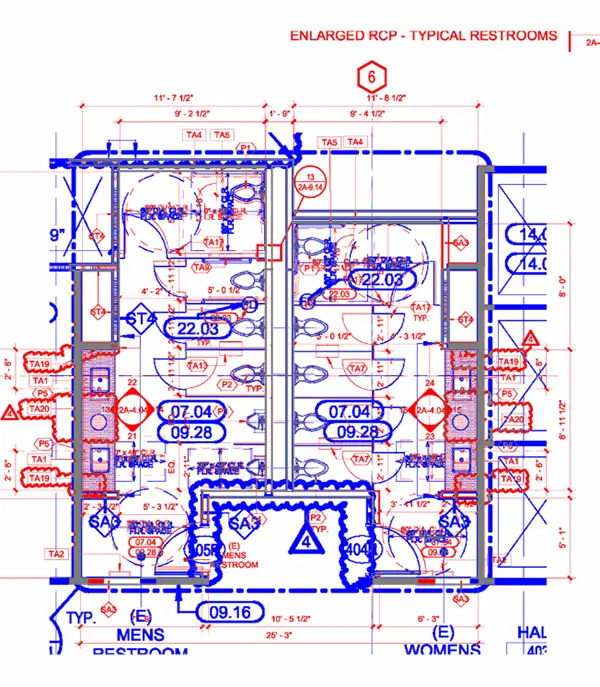RFIs Made Easier. For Everyone.
AI for preconstruction design review creates unexpected efficiencies, clarity, and faster response times for improved decision-making.
Published Aug 22, 2024 | By Wendi Burke

The Request for Information (RFI) process in construction, is something we are all familiar with. Whether you’re a contractor, owner, or architect, RFIs are a part of every project and come at a high cost. An often-quoted research study in 2013 by Navigant Construction Forum places the average construction RFI cost at an estimated $1,080 to review and respond to, with the process taking a median of 9.7 days, and 21.9% going with no response at all; a conservative estimate with today’s skyrocketing costs.
With a current average value between $2,000 to $3,000 per RFI, not including indirect costs like delays and rework, it’s clear that approaching RFIs effectively is crucial for saving time, money, and harmonious collaboration between project stakeholders.
Efficiency
Design and preconstruction teams can benefit greatly from utilizing AI drawing review tools. Architects can save significant time, and headaches having to research and respond to easily preventable RFI’s, not to mention the hit that unchecked RFIs can have on a firm’s reputation. That said, contractors typically carry the most risk on a project making such tools essential. If you consider that on average, a project team will rack up 6,368 hours dealing with RFIs, costing around $859,680 (according to the Navigant study), it’s clear that better solutions are needed; especially when a single RFI has a potential impact of 9.7 days on the project schedule.
For preconstruction teams who can either become project heroes or project villains, AI tools that can quickly identify missing information, scope gaps, and conflicting information in drawing sets— before bid or procurement—can mean the difference between project profits and losses.
In a recent case study, Flintco, an industry-leading champion of technology and innovation, looked at RFIs and how information applied during preconstruction can help operations teams deliver more schedule and budget certainty for owners. The goal was to improve bid accuracy and streamline procurement by mitigating uncertainty from incomplete design packages earlier and more efficiently.
Flintco leveraged a preconstruction AI design review tool called Firmus AI-REVIEW™ on a large healthcare facility in their Southeast Region. What would normally take 2-3 weeks of tedious manual review, was accomplished in 48 hours with the AI analysis identifying, among other things, discrepancies between the door schedule and the doors shown on the floor plans and other views.
“That analysis helped us pinpoint and streamline those issues,” said Nicole McKee, Estimator & Diversity Coordinator at Flintco in Memphis. “We grouped all the relevant conflicts in one RFI for each building. For instance, if a door was shown on the door schedule but not on the floor plan, we would list them all for each building grouped under main topics.” The amount of time saved was impressive. “I can honestly say the Firmus analysis for the generation of RFIs alone, saved us days.”
Preconstruction teams can leverage AI to increase productivity and resource optimization while reducing their project and business risk. And when teams can focus on the strategic aspects of project design and constructability, employee satisfaction and retention increase. The natural result is higher project quality, cost-controlling, and clarity.
Clarity
Project teams are engaged in the build process earlier today than they were in the past, working from documents in design. Not optimal when developing budgets and schedules and trying to beat supply chain shortages and delays with early procurement is critical for success. It’s also not optimal for architects or owners who know that RFIs will be forthcoming.
AI tools can help improve project clarity and decision-making, no matter which side of the fence you’re sitting on. One of the basic tenets of the RFI process is to make clear requests. AI tools like Firmus, designed by construction industry experts in collaboration with architects can provide clear document markups with the supporting context needed to quickly and easily review the identified issue(s). These expert markups combined with drawing overlays where applicable, make the RFI review, response, and resolution easier for everyone involved.

Collaboration
If a typical project has between 15 to 20 RFI’s per $1M in project value, and a single RFI takes an average of 9.7 days to receive a response, the loss of time and resulting delays and rework can be staggering. In fact, according to Navigant Construction Forum, 30% of the work performed by construction companies is rework.
Leveraging AI tools during the design and preconstruction stages could greatly reduce the rework epidemic, especially those that allow for cooperative collaboration. After all, collaboration equals faster response times.
Nibbi Brothers General Contractors shared in a recent case study it has learned from decades of experience that the right approach is honest, collaborative, proactive, and supported by advanced technology. Nibbi knows that early team collaboration and proactive problem-solving can help maximize quality and avoid significant problems down the road.
“We recently had a project where the architect was impressed that we’re using an AI tool,” said Anita Hsieh, AIA QA Project Manager at Nibbi. “We started scanning drawings, maybe in the mid CDs, and overall, you can sense the level of drawing competency increases each time they submit. I think the architect appreciates having multiple tools at their disposal. It’s more like a team effort. It’s improved the way we interact with them over time. I also think they appreciate the thoroughness of the reviews we do and the time we’re putting into it. We’re all trying to get the set to be the best it can be.”
Cloud-based software like Firmus allows for unlimited users, allowing contractors and design firms to invite all relevant stakeholders to assigned projects for enhanced collaboration. Ensuring everyone has access to the same identified issues, document markups, and view comparisons enables a more cohesive approach, ultimately saving time and money.
Conclusion
A 2024 IFS Construction & Engineering report predicts that 90% of construction companies will simplify their business system landscape with cloud-based technology in the next 5 years, and 30% of companies will deploy AI and Automation within the next 3 years.
Preconstruction AI is making huge strides in increasing productivity, resource optimization, employee satisfaction, and retention for contractors, architects, and owners. Users achieve reductions in project and business risk, while improving business performance and informed decision-making.
Don’t accept a 9% to 30% profit loss on every project because of missing information and rework. Support your team with AI design review tools that provide improved efficiency, clarity, and collaboration. Make RFIs easier for everyone and increase project quality and cost controlling. Ultimately, you’ll enjoy increased profits and company valuation. Who can say no to that?

